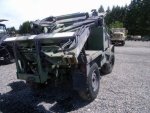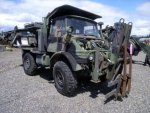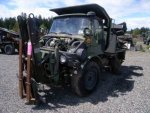Wolf.Dose
Active member
- 1,062
- 9
- 38
- Location
- Boehl-Iggelheim, Germany
The SEE's were built to the requirement of the Corps of Engineering in some 30 years ago. They were thought to dig some small holes, remove some small plies of dirt and so on which takes too long by hand. If you use the SEE to that what they are designed for, they are very nice. If you use them as 30 ton excavator equivalent, you use the wrong equipment. And do not compare the SEE with equipment designed 30 years later.
Basically the SEE is a 406, however, to make for Unimog the differences clear to define, they named it 419.
For Germany the designe of the attachments were by that time standard use, nothing compareable available in the US. To make ist under the "Buy American" possible to buy the SEE, it was sold under the Freightliner brand.
John Deere tractors (JD 40 Series and 45 Series, for Europe also as 40 kph versions available) or Case tractors by that time had a max speed of 18 to 20 mph in the US, the SEE 50 mph. And by that time most US tractors were 2WD.
From the point of safety (todays understanding) the backhoes for these tractors were a nightmare.
Wolf
Basically the SEE is a 406, however, to make for Unimog the differences clear to define, they named it 419.
For Germany the designe of the attachments were by that time standard use, nothing compareable available in the US. To make ist under the "Buy American" possible to buy the SEE, it was sold under the Freightliner brand.
John Deere tractors (JD 40 Series and 45 Series, for Europe also as 40 kph versions available) or Case tractors by that time had a max speed of 18 to 20 mph in the US, the SEE 50 mph. And by that time most US tractors were 2WD.
From the point of safety (todays understanding) the backhoes for these tractors were a nightmare.
Wolf









